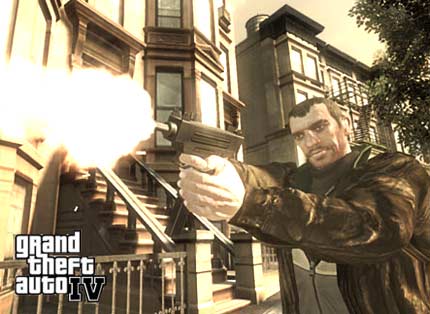
By Justin Calvert, GameSpotPosted Apr 2, 2008
We team up with the lead designer of Saints Row 2 for some cooperative chaos-making.
Earlier today, during a meeting with THQ and Volition, we had an opportunity to play Saints Row 2 for the first time. Joining us in the city of Stilwater was the game's lead designer, James Tsai, who was kind enough to play through a stronghold mission and a helicopter activity with us in the two-player co-op mode before the session degenerated into an infinite-ammo-fueled rampage.
Saints Row 2 promises a user-friendly approach to cooperative gameplay that'll let you jump in and out of online co-op games at any time, regardless of how far into the campaign each player is. You'd have to be pretty dedicated to playing alongside a friend to completely avoid playing solo for fear of getting out of sync with each other, after all. You'll be able to help other players out with missions that you've already beaten, of course, but what's really neat is that when playing alongside someone who's a lot further into the story than you you'll have the option of playing through their missions as well. Said missions would almost certainly be unavailable to you in single-player mode at that time, but the game will remember that you've beaten them in co-op and, when you reach them in your own story, will give you the option to skip them accordingly.
The mission that we played through during today's session tasked us with taking down the same Sons of Samedi stronghold that we were given a brief tour of the last time we saw Saints Row 2 in action. The stronghold is a trailer park where the Caribbean-influenced gang manufactures a designer drug known as Lower Dust. Our goal was to destroy five trailers being used as labs, and thanks to a cheat that afforded us infinite ammo for every weapon in our arsenal, we had no shortage of toys with which to accomplish it. Favorite weapons on this occasion included a shotgun, an assault rifle, a rocket-propelled grenade launcher, and satchel charges. The two guns were effective at close- and long-range, respectively; the RPG was useful because it locks on to targets pretty quickly if you position your crosshair over them; and the satchel charges are a lot of fun because they adhere to just about anything (or anyone) you throw them at and can then be detonated manually.
While playing through the stronghold mission we were free to work as closely with or as independently from the other player as we liked, though since you'll have the ability to revive each other when you die it's definitely a good idea to stay pretty close. Simply taking the shortest route through the mission and blowing up the five trailer labs wasn't terribly difficult with two players, and even with numerous gang members attempting to stop us we rarely needed to worry about retreating into cover so that our health could replenish. Our first play-through of the mission was a little underwhelming, to be honest, but that's only because it was a little too easy to beat with an overpowered arsenal that we hadn't started to get creative with yet.
That all changed on our second play-through. Landing satchel charges on a stationary target as big as a trailer isn't very challenging or particularly satisfying, but landing those same charges on cars as they drive by or even on unsuspecting pedestrians who then go into a panic is infinitely more enjoyable. By sticking a couple of charges onto a car and then driving it toward one of the trailers before bailing out and hitting the detonate button, Tsai also showed us how seemingly innocuous vehicles can effectively be turned into powerful missiles. The new cruise control feature that lets you keep your vehicle's speed constant while freeing up your accelerator thumb for other things proved useful here, though its intended purpose is really just to make drive-bys easier. By adhering multiple charges to a pedestrian and then detonating them individually it's even possible to "juggle" the target using explosions to keep them in the air, and when the day comes that we're allowed to capture our own footage of Saints Row 2, you can bet that'll be one of the first things we try.
Another fun feature of Saints Row 2 that we experimented with while playing through the stronghold mission is the ability to grab pedestrians and use them as human shields. Gang members and cops are somewhat reluctant to fire at their own people when you're hiding behind them, and even innocent civilians that gang members will fire upon without a second thought do a good job of soaking up bullets for a time. When you no longer need your human shields, you have the option to execute them with a quick headshot (that doesn't work with the RPG, we discovered; you just break their necks instead) or simply push them away--preferably toward a fire or fast-moving vehicle so that there's no danger of them trying to exact revenge.
The helicopter activity that we played through next will, like other activities, be completely optional as you progress through the game. On this occasion we were tasked with providing air support for a friendly vehicle that was being used to complete a drug deal and coming under fire from rival gangs. In co-op mode, helicopter activities have one player jump into the pilot seat while the other uses a chaingun and laser-guided missile system to take out hostiles. The chaingun seemed a little underpowered on this occasion, while the missiles were perhaps just a little too quick and easy to fire and forget.
We completed the activity from the gunner's seat with a minimum of fuss after shooting down a number of enemy helicopters and blowing up plenty of hostile vehicles on the streets below. We were eager to pilot a helicopter for ourselves, though, so we had Tsai show us to a location where we could jack one and just fly around without having to concern ourselves with objectives. Predictably, the controls for the chopper were a little more complex than those for cars and bikes, but they're still quite easy to pick up. Your accelerator and brake buttons are the same as they are on the street, except that they can also be used to influence altitude, you still steer with the left analog stick and move the camera with the right, and you can use the shoulder buttons to rotate left and right.

The work-in-progress demo version of Saints Row 2 that we were playing on this occasion afforded us the opportunity to explore only a portion of one of islands that make up the gameworld. From our vantage point inside a helicopter flying high above, though, we were still impressed by the scale of the environment and by the variety of the neighborhoods that we could see. As we flew from one end of the island to the other, we left the trailer park behind and headed toward a large, modern-looking city before ultimately ending up at a museum site that incorporated what appeared to be the ruins of an ancient temple. That's where we ditched the chopper (OK, crashed it) and decided to have some more fun with satchel charges before bringing the session to an end. A few hundred explosions later we still weren't bored of them, and we'd managed to attract the attention of several SWAT teams by the time we reluctantly put down the controller.
Saints Row 2 is currently scheduled to ship to stores later this year. No more-specific release date information has been announced at this time, though we're assured that it will be soon. We'll bring you more information on Saints Row 2 as soon as it becomes available.



















































